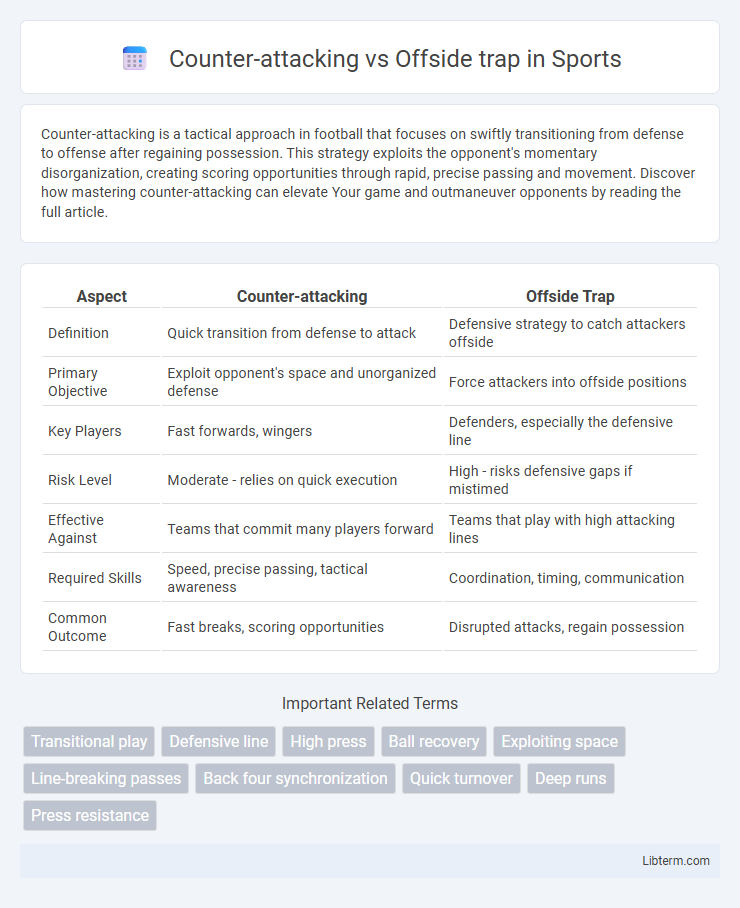Counter-attacking is a tactical approach in football that focuses on swiftly transitioning from defense to offense after regaining possession. This strategy exploits the opponent's momentary disorganization, creating scoring opportunities through rapid, precise passing and movement. Discover how mastering counter-attacking can elevate Your game and outmaneuver opponents by reading the full article.
Table of Comparison
| Aspect | Counter-attacking | Offside Trap |
|---|---|---|
| Definition | Quick transition from defense to attack | Defensive strategy to catch attackers offside |
| Primary Objective | Exploit opponent's space and unorganized defense | Force attackers into offside positions |
| Key Players | Fast forwards, wingers | Defenders, especially the defensive line |
| Risk Level | Moderate - relies on quick execution | High - risks defensive gaps if mistimed |
| Effective Against | Teams that commit many players forward | Teams that play with high attacking lines |
| Required Skills | Speed, precise passing, tactical awareness | Coordination, timing, communication |
| Common Outcome | Fast breaks, scoring opportunities | Disrupted attacks, regain possession |
Understanding Counter-Attacking Football
Counter-attacking football emphasizes quick transitions from defense to attack, exploiting spaces left by opponents during their offensive plays to create high-quality scoring opportunities. It relies on swift, accurate passing and rapid movement to catch opposing defenses unprepared, often capitalizing on speed and tactical awareness of forwards and midfielders. Understanding the difference from an offside trap, which is a defensive strategy designed to catch attackers offside, highlights counter-attacking's proactive approach focused on exploiting attacking chances rather than defensive positioning.
What is the Offside Trap?
The offside trap is a defensive strategy used in soccer where defenders step forward just before an opponent passes the ball, leaving the attacker in an offside position and nullifying the play. It requires precise timing and coordination among the defensive line to catch opposing forwards offside and regain possession. This tactic contrasts with counter-attacking, which focuses on rapid offensive transitions after winning the ball.
Key Principles of Counter-Attack Tactics
Counter-attacking tactics rely on rapid transitions from defense to offense, exploiting the opponent's momentary disorganization while emphasizing quick, precise passing and forward runs. Key principles include maintaining compact defensive shape, swift ball recovery, and exploiting spaces left behind by an aggressive opponent pushing forward. Effective counter-attacks demand disciplined positioning, anticipation of opponent movements, and swift decision-making to capitalize on numerical or spatial advantages before the offside trap can be reset.
Mechanics Behind an Effective Offside Trap
The mechanics behind an effective offside trap rely on precise synchronization and communication among defenders to step up at the exact moment an opponent attempts a forward pass. Timing and spatial awareness are critical, as defenders must anticipate the striker's movement and ensure the offside line is maintained just beyond the last attacker. Successful execution disrupts counter-attacks by catching opponents offside, forcing turnovers and halting rapid offensive transitions.
Strengths of the Counter-Attacking Approach
Counter-attacking football excels in exploiting the opponent's advanced positioning by rapidly transitioning from defense to offense, creating high-percentage scoring opportunities. This approach leverages the speed and positioning of forwards to capitalize on spaces left behind during aggressive attacks. Defensive solidity combined with swift counter movements often disrupts teams attempting the offside trap, rendering their strategy less effective.
Advantages and Risks of the Offside Trap
The offside trap offers strategic advantages by disrupting the opponent's attacking flow and catching forwards offside, thereby regaining possession and reducing defensive pressure. However, risks include the potential for mistimed execution causing defenders to be caught out, resulting in dangerous one-on-one situations against the goalkeeper. Effective communication and precise coordination in the defensive line are critical to maximizing the offside trap's effectiveness while minimizing vulnerabilities.
Tactical Setups: Counter-Attack vs Offside Trap
Counter-attacking tactical setups prioritize quick transitions from defense to offense, using rapid forward passes and exploiting space behind the opposition's defense, often with a compact midfield ready to launch fast breaks. The offside trap relies on a high defensive line and coordinated positioning among defenders to catch opponents offside, requiring precise timing and strong communication within the backline to execute effectively. Teams opting for counter-attacks tend to absorb pressure and break quickly, while offside trap strategies force opponents into risky, ill-timed runs to retain control defensively.
Player Roles and Positioning Dynamics
Counter-attacking relies on quick transitions where forwards and wingers exploit spaces behind opponents by making rapid, forward runs, while midfielders focus on swift ball recovery and distribution to initiate attacks. In an offside trap, defenders work cohesively as a unit, stepping up in unison to catch opposing forwards offside, requiring precise positioning and communication. Midfielders support this by cutting passing lanes and forcing attackers into risky runs, emphasizing strategic spatial awareness and timing.
Famous Matches Illustrating Each Tactic
The 2014 FIFA World Cup quarter-final between Germany and France showcased a masterful counter-attacking strategy, as Germany capitalized on swift transitions to score decisive goals. In contrast, the 2010 UEFA Champions League final saw Inter Milan effectively implement the offside trap, with defender Walter Samuel orchestrating a near-perfect defensive line that caught Barcelona's attackers offside multiple times. These matches highlight how both counter-attacking and the offside trap can shape high-stakes football outcomes through tactical discipline and timing.
Choosing the Right Strategy for Your Team
Selecting the appropriate strategy between counter-attacking and the offside trap depends on your team's defensive organization, speed, and tactical discipline. Counter-attacking requires fast transitions and players with strong pace to exploit opponent vulnerabilities effectively, while mastering the offside trap demands precise coordination and timing from the defensive line to catch attackers offside consistently. Analyzing your squad's strengths and opponent tendencies ensures the chosen approach maximizes defensive solidity and offensive opportunities.
Counter-attacking Infographic

 libterm.com
libterm.com